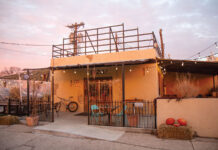
Launched in 2014, New Riff Distilling (https://newriffdistilling.com) has been a standout craft distillery for the Cincinnati area, just a couple blocks off the Ohio River on the Kentucky side. Their rye and gin were the most memorable and balanced local spirits I tasted on a recent visit to Cincy.
Producing Kentucky bourbon, rye and bottled-in-bond whiskeys as well as gin, New Riff was founded by Ken Lewis, a Kentucky liquor retailer and entrepreneur. Lewis doesn’t come from just any liquor store — he opened the great Party Source (https://thepartysource.com), America’s largest keg beer store equally known for its massive spirits selection.
Jay Erisman worked for Lewis at the Party Source from 2001 to 2014 and was behind launching their famed spirits program. He also worked closely with Kentucky’s bourbon distilleries to create new whiskeys, hosting cooking classes and creating wine and spirits tasting curricula. If this wasn’t impressive enough, he’s also a writer who has written about spirits in Whisky Advocate, Distiller and Edible Ohio Valley, to name a few.
Lewis and Erisman started working on New Riff Distilling in 2010. Erisman serves as Vice President of Strategic Development, “the whiskeyman,” distiller and truck driver. Here, in his own words, Erisman describes the “new riff on an old tradition” mindset behind their spirits and how being successful ex-liquor retailers informs their approach to intensely competitive on-premise sales.
What led you to distilling and spirits?
Ultimately, it was one of those hobbies that turned into a career. I started learning about single malt Scotch and bourbon as a freshman in college and it just went on from there. I was a homebrewer back then, so that taught me about fermentation. In 2001, I went to work for Ken Lewis as the fine spirits manager at The Party Source, and that was my entry into formally working in the spirits industry. Between the two of us, I guess, Ken and I cooked up the idea to start a distillery: me, from the creative side, and certainly Ken supplied the spirit of entrepreneurship. But he also built the tremendous team we have making this stuff.
What spirits do you consider your flagship spirits?
Well, of course we would make bourbon, coming from Kentucky! We make bourbon and rye, primarily, along with a host of other projects that haven’t yet seen the light of day. We also make a terroir-driven gin distilled with wild-foraged Ohio Valley botanicals. Our creative approach is encapsulated in our name: we are a “new riff on an old tradition.” Which means, we first had to learn the tradition, and only then could we make a riff on it. That tradition is Kentucky-style sour mash whiskey making. In the fullness of time you’ll see more and more — and heavier and heavier — “riffs” emerge from our warehouse.
Tell us about your distilling process — what is unique to what you do?
You know, in many ways there’s not anything amazingly different about our approach to distillation. We produce sour mash whiskey in classic Kentucky fashion. We haven’t reinvented the wheel.
We have a column beer still feeding a doubler, just like all the big distilleries in the state; ours is just a smaller version, and the entire distillation path is copper, instead of the stainless steel stills some distillers use. But at every point in the process, we make very intentional choices in favor of flavor. Like zesty-spicy high-rye mashbills; our private aquifer water supply, with four times the dissolved minerals of typical municipal water; a yeast strain that produces a lot of high, oily flavors; a low 135 proof off the doubler; a good, strong 100 proof in the bottle (everything is bottled in bond, except single barrels which are barrel proof); and no chill filtration going into the bottle, so all that goodness is preserved into your glass. There is no one magic thing, no silver bullet, that explains New Riff’s flavor: it is all of these factors, all these choices on the part of our team, taken together.
How does living in Greater Cincinnati determine the focus of your business?
The fact that we are on the south bank of the Ohio River certainly meant we would focus on bourbon. There are also a lot of resources available to a new distiller in Kentucky and a lot of camaraderie among all the distillers, small and large, and that helped us, too.
One of our local inspirations is the fact that Greater Cincinnati had a bit of a reputation as a rye town, as opposed to strictly bourbon like you might find further south in Kentucky. Before Prohibition, Cincinnati was in fact the biggest whiskey market in the country, and while a lot of that was rectified whiskey, they also produced a good bit of rye. We acknowledge that history in our own high-rye identity. In fact, six years in, we have mashed more rye grain than corn and, even more surprising, we have mashed more malted rye than malted barley.
How have you grown your brand at bars and beyond? What advice would you give to fellow distillers?
The on-premise trade is brutally competitive. Most of the large brands and companies view on-premise as a take-no-prisoners field, and they lavish a lot of marketing and other monies on that competition. They view on-premise as the “brand builder,” and then that’s supposed to carry over to off-premise retail. At New Riff, we don’t always think that way. As ex-liquor retailers ourselves, we believe stores can build brands, too. In some markets, for the moment, we’ve been content to build great relationships with a handful of excellent retailers. That said, we love us the bars, too.
If I had any suggestions about on-premise, it might sound repetitive but it has to start with excellent quality products. In the bar, the distiller really has to make two sales: convincing the bartender to stock your bottle and then the consumer to order it in a drink. And if you don’t sway that bartender, she won’t likely move it into her customer’s cocktail. If there’s a bar manager between you and the bartender, that makes three sales. So your booze needs to be really good.
You also need to have a realistic price. A lot of bars want base cocktail ingredients that are about a dollar an ounce (there’s a reason Bulleit Rye costs about $25 per 750-ml). If your handcrafted rye whiskey in a 375-ml bottle runs an MSRP of fifty bucks, you’re going to have a harder time selling that to a bartender (or even worse, the bar manager, who is looking out for the bar owner’s profits).
What is exciting you most about the renaissance of “craft” spirits and cocktails?
I love to see more and more distilleries, both small and large, embracing a bottling regimen without chill filtration. It leaves so much more texture, more character, more life in the bottle than the typical industrial-grade filtration. It helps the character of the whiskey tasted straight in the glass, but it also shines in cocktails, carrying all the flavors and, importantly, the texture of the spirit through to the end of the cocktail. Try an unfiltered old fashioned — you’ll never go back.








